冀教版初一英语上每课重点(完整资料).doc
- 格式:doc
- 大小:82.81 KB
- 文档页数:23
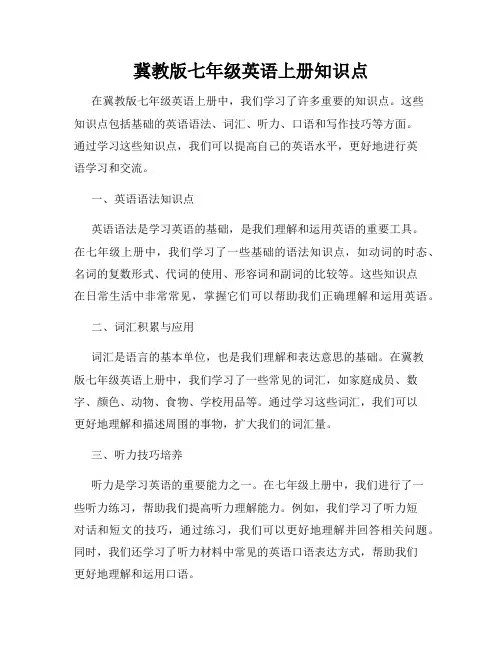
冀教版七年级英语上册知识点在冀教版七年级英语上册中,我们学习了许多重要的知识点。
这些知识点包括基础的英语语法、词汇、听力、口语和写作技巧等方面。
通过学习这些知识点,我们可以提高自己的英语水平,更好地进行英语学习和交流。
一、英语语法知识点英语语法是学习英语的基础,是我们理解和运用英语的重要工具。
在七年级上册中,我们学习了一些基础的语法知识点,如动词的时态、名词的复数形式、代词的使用、形容词和副词的比较等。
这些知识点在日常生活中非常常见,掌握它们可以帮助我们正确理解和运用英语。
二、词汇积累与应用词汇是语言的基本单位,也是我们理解和表达意思的基础。
在冀教版七年级英语上册中,我们学习了一些常见的词汇,如家庭成员、数字、颜色、动物、食物、学校用品等。
通过学习这些词汇,我们可以更好地理解和描述周围的事物,扩大我们的词汇量。
三、听力技巧培养听力是学习英语的重要能力之一。
在七年级上册中,我们进行了一些听力练习,帮助我们提高听力理解能力。
例如,我们学习了听力短对话和短文的技巧,通过练习,我们可以更好地理解并回答相关问题。
同时,我们还学习了听力材料中常见的英语口语表达方式,帮助我们更好地理解和运用口语。
四、口语表达能力提升口语是学习英语的关键能力之一。
在冀教版七年级英语上册中,我们学习了一些常用的口语表达方式,如问候、自我介绍、购物、订餐、日常生活对话等。
通过模仿和练习,我们可以提高口语表达能力,更好地应用英语进行日常交流。
五、写作技巧训练写作是学习英语的重要技能之一。
在七年级上册中,我们学习了一些常见的写作技巧,如如何写一封信、如何写一篇日记、如何进行图表描述等。
通过练习,我们可以提高自己的写作能力,更好地表达自己的想法和感受。
综上所述,冀教版七年级英语上册是我们学习英语的重要阶段之一。
通过学习这些知识点,我们可以提高自己的英语能力,更好地应对日常生活和学习中的英语交流。
希望大家能够充分利用这些知识点,不断提高自己的英语水平,取得更好的学习成果。
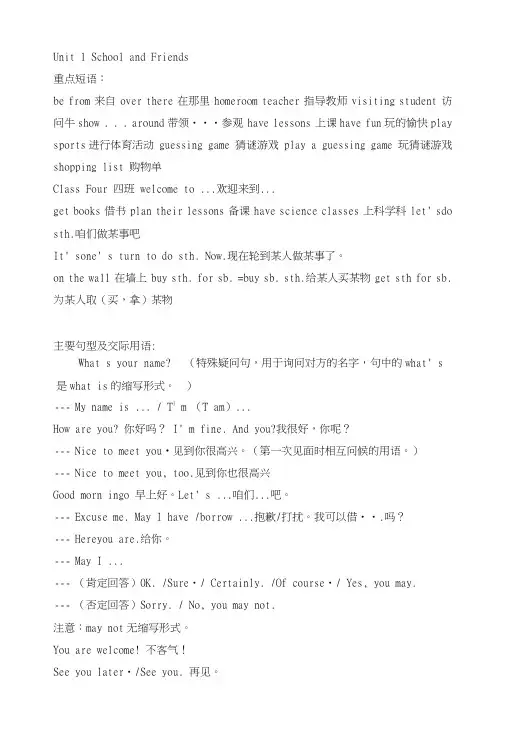
Unit 1 School and Friends重点短语:be from 来自 over there 在那里 homeroom teacher 指导教师 visiting student 访问牛show . . . around带领・・・参观have lessons 上课have fun玩的愉快play sports进行体育活动 guessing game 猜谜游戏 play a guessing game 玩猜谜游戏shopping list 购物单Class Four 四班 welcome to ...欢迎来到...get books 借书plan their lessons 备课have science classes 上科学科let' sdo sth.咱们做某事吧It' sone' s turn to do sth. Now.现在轮到某人做某事了。
on the wall 在墙上buy sth. for sb. =buy sb. sth.给某人买某物get sth for sb.为某人取(买,拿)某物主要句型及交际用语:What s your name? 是what is的缩写形式。
(特殊疑问句,用于询问对方的名字,句中的what' s )--- My name is ... / T1 m (T am)...How are you? 你好吗? I' m fine. And you?我很好,你呢?--- Nice to meet you•见到你很高兴。
(第一次见面时相互问候的用语。
)--- Nice to meet you, too.见到你也很高兴Good morn ingo 早上好。
Let' s ...咱们...吧。
--- Excuse me. May I have /borrow ...抱歉/打扰。
我可以借・・.吗?--- Hereyou are.给你。
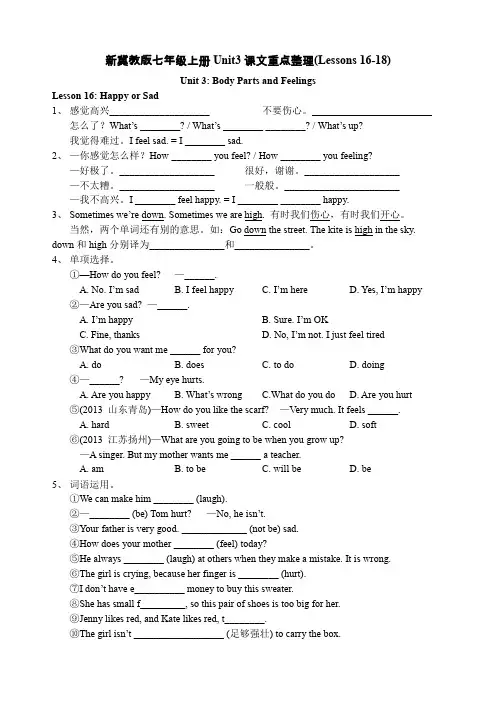
新冀教版七年级上册Unit3课文重点整理(Lessons 16-18)Unit 3: Body Parts and FeelingsLesson 16: Happy or Sad1、感觉高兴____________________ 不要伤心。
________________________怎么了?What’s ________? / What’s ________ ________? / What’s up?我觉得难过。
I feel sad. = I ________ sad.2、—你感觉怎么样?How ________ you feel? / How ________ you feeling?—好极了。
___________________ 很好,谢谢。
___________________—不太糟。
___________________ 一般般。
_______________________—我不高兴。
I ________ feel happy. = I ________ ________ happy.3、 Sometimes we’re down. Sometimes we are high. 有时我们伤心,有时我们开心。
当然,两个单词还有别的意思。
如:Go down the street. The kite is high in the sky. down和high分别译为_______________和_______________。
4、单项选择。
①—How do you feel? —______.A. No. I’m sadB. I feel happyC. I’m hereD. Yes, I’m happy②—Are you sad? —______.A. I’m happyB. Sure. I’m OKC. Fine, thanksD. No, I’m not. I just feel tired③What do you want me ______ for you?A. doB. doesC. to doD. doing④—______? —My eye hurts.A. Are you happyB. What’s wrongC.What do you doD. Are you hurt⑤(2013 山东青岛)—How do you like the scarf? —Very much. It feels ______.A. hardB. sweetC. coolD. soft⑥(2013 江苏扬州)—What are you going to be when you grow up?—A singer. But my mother wants me ______ a teacher.A. amB. to beC. will beD. be5、词语运用。
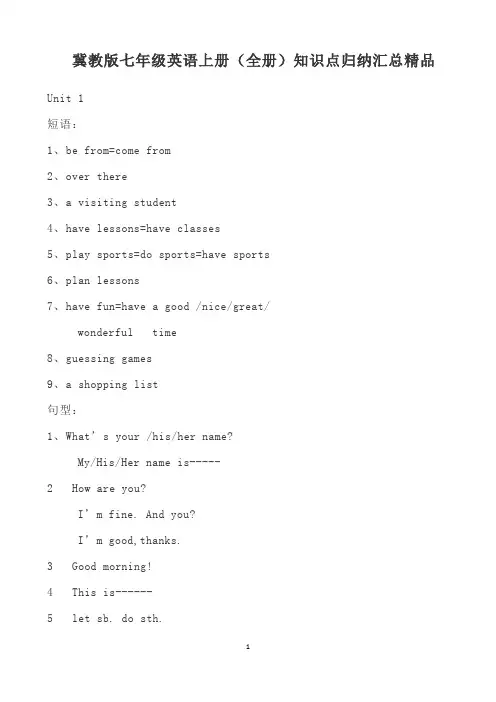
冀教版七年级英语上册(全册)知识点归纳汇总精品Unit 1短语:1、be from=come from2、over there3、a visiting student4、have lessons=have classes5、play sports=do sports=have sports6、plan lessons7、have fun=have a good /nice/great/wonderful time8、guessing games9、a shopping list句型:1、What’s your /his/her name?My/His/Her name is-----2 How are you?I’m fine. And you?I’m good,thanks.3 Good morning!4 This is------5 let sb. do sth.6 show sb.around7 It’s one’s turn to do sth.8 Excuse me.May I have/borrow-----?9 See you later.10 Here you are!11 You are welcome.12 need to do sth.13 How/What about (doing) sth.?14 make a listUnit 2短语:1、look at2、come out3、in the sky4、be/get ready for5、say goodbye to6、catch a cold7、go back/come back8、put on--take off9、go well with10、take......out of11、around the world=all over the world 句型:1、mix A and B---mix......together2、What’s your favourite colour?3、How many colours do you see?4、Whose ......is this?5、be/get ready to do sth.6、Let’s go shopping.7、It’s too small/big/long/short for me.Unit 3短语:1、play with2、do one’s homework3、feel blue4、see red5、listen to6、wave one’s hand7、stand against/upon8、see a doctor9、take the medicine10、have a headache/stomachache11、stay home12、have a good rest13、look different/the same句型:。
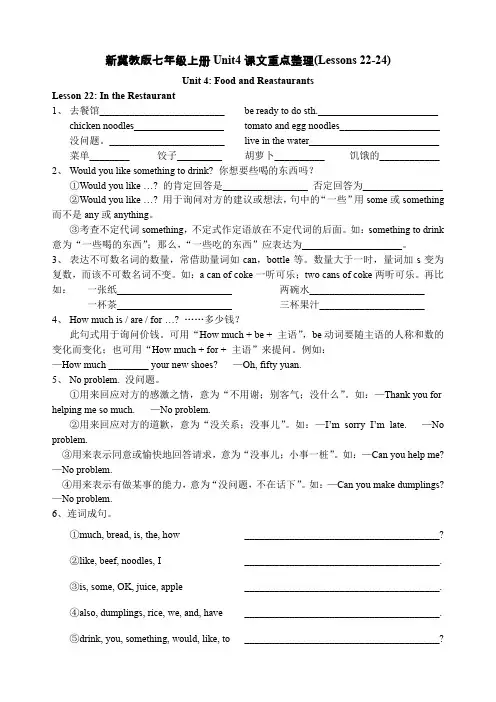
新冀教版七年级上册Unit4课文重点整理(Lessons 22-24)Unit 4: Food and ReastaurantsLesson 22: In the Restaurant1、去餐馆_________________________ be ready to do sth.________________________chicken noodles__________________ tomato and egg noodles____________________ 没问题。
_______________________ live in the water__________________________ 菜单________ 饺子_________ 胡萝卜__________ 饥饿的____________2、 Would you like something to drink? 你想要些喝的东西吗?①Would you like …? 的肯定回答是_________________ 否定回答为________________②Would you like …? 用于询问对方的建议或想法,句中的“一些”用some或something 而不是any或anything。
③考查不定代词something,不定式作定语放在不定代词的后面。
如:something to drink 意为“一些喝的东西”;那么,“一些吃的东西”应表达为____________________。
3、表达不可数名词的数量,常借助量词如can,bottle等。
数量大于一时,量词加s变为复数,而该不可数名词不变。
如:a can of coke一听可乐;two cans of coke两听可乐。
再比如:一张纸_______________________ 两碗水_______________________ 一杯茶_______________________ 三杯果汁_____________________4、 How much is / are / for …? ……多少钱?此句式用于询问价钱。
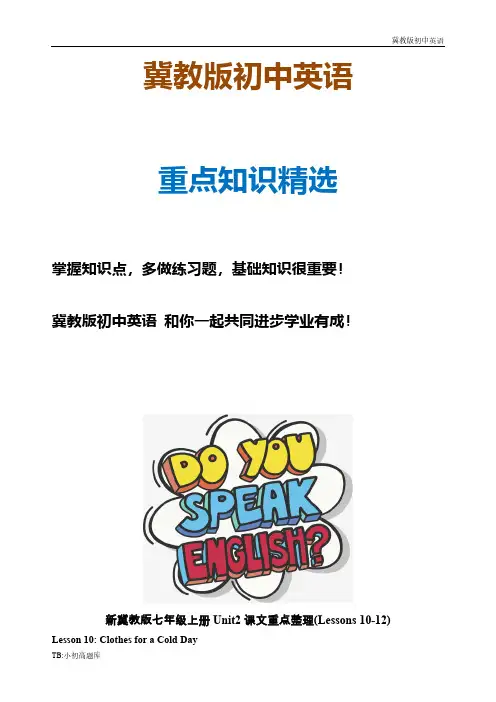
冀教版初中英语重点知识精选掌握知识点,多做练习题,基础知识很重要!冀教版初中英语和你一起共同进步学业有成!新冀教版七年级上册Unit2课文重点整理(Lessons 10-12) Lesson 10: Clothes for a Cold Day1、准备上课____________________ say goodbye to… ___________________看起来漂亮_________________ catch a cold ________________________回去_______________________ put on a jacket ______________________我的书包___________________ go well with … _____________________2、 Danny is ready for school. 丹尼准备好上学了。
ready adj.预备/准备好的,常见搭配:①be ready 意为“准备好”Is supper ready? ________准备好了吗?②be ready for 意为“为……做好准备”We are ready for work. 我们已经准备好________了。
③be ready to do sth. 为固定搭配,意为“准备好做某事”。
We are ready to take a bus to Beijing. 我们准备________去北京。
3、I look nice in this green T-shirt. 我穿着这件绿色T恤看起来不错。
在此句中,介词in是“穿”的意思,后面跟表衣物的名词或表颜色的衣物名词,意思为“穿………衣服”或“穿………颜色的衣服”。
如:Do you know the man in the black coat? 你认识__________________的那个人吗?Who is the girl ____________? 穿红色衣服的那个女孩是谁?4、You may catch a cold. 你也许会感冒。

七年级上英语冀教版知识点英语作为世界上最广泛使用的语言,对于我们学习英语来说,是不可或缺的一门必修课。
作为初学英语的我们,在掌握语音、语法基础的同时,还需要了解一些英语的基本知识点。
本文将为大家详细介绍七年级上英语冀教版的知识点。
一、语音1. 英语音标英语音标是英语学习中非常重要的一个知识点。
学好英语音标可以帮助我们更准确、准确地发音,提高自己的英语口语水平。
2. 单、双元音和辅音音节单元音指的是一个音节由一个元音发音组成,如“apple”中,“a”就是一个单元音;双元音指的是一个音节由两个元音发音组成,如“boy”中,“oy”就是一个双元音;辅音音节指的是一个音节由一个辅音和一个元音组成,如“cat”中,“c”是辅音,“a”是元音。
二、语法1. 词性在英语中,词性分为名词、代词、形容词、副词、动词、介词、连词和感叹词。
掌握词性对于我们进行语法分析非常有帮助。
2. 句型英语句子有简单句、并列句、复合句等不同的句型。
掌握不同的句型可以让我们在表达意思时更加清晰明了。
3. 时态英语时态共有12种,主要分为过去时、现在时和将来时。
掌握时态的变化规则,可以帮助我们更准确地表达过去、现在和将来的事情。
三、词汇1. 常用词汇常用词汇是我们平时最常用的单词,如人称代词、颜色、数字、日期、星期等等。
我们需要掌握这些常用词汇,以便我们在进行英语交流时更加便利。
2. 词根、词缀、派生词在英语中,很多单词由一个词根和一个或多个词缀组成,这些单词叫做派生词。
了解这些词根和词缀的意义,可以帮助我们更容易记忆单词。
四、阅读理解1. 阅读技巧阅读是英语学习中非常重要的一环,需要我们掌握一些阅读技巧,如扫读、略读、详读等,以便我们更好地理解阅读内容。
2. 阅读材料阅读材料根据我们的水平不同,可以选择适合我们的阅读材料。
对于初级阶段的学生,可以选择一些简单的故事、小说、科普文章等。
五、写作1. 写作结构英语写作需要我们掌握一些写作结构,如开头、中间、结尾等,以便我们清晰地表达自己的思想和观点。
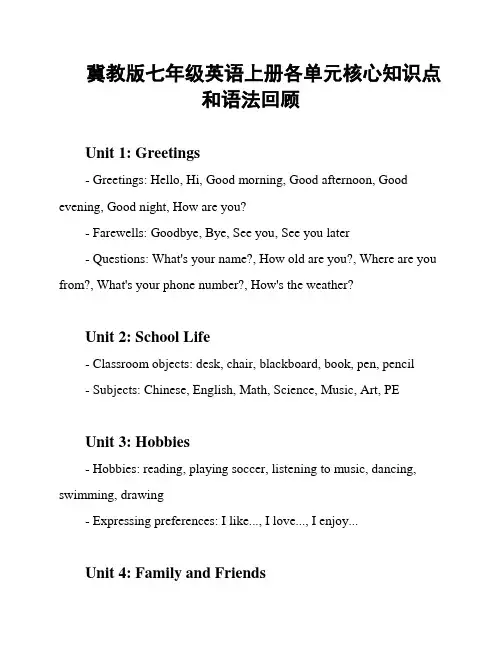
冀教版七年级英语上册各单元核心知识点和语法回顾Unit 1: Greetings- Greetings: Hello, Hi, Good morning, Good afternoon, Good evening, Good night, How are you?- Farewells: Goodbye, Bye, See you, See you later- Questions: What's your name?, How old are you?, Where are you from?, What's your phone number?, How's the weather?Unit 2: School Life- Classroom objects: desk, chair, blackboard, book, pen, pencil- Subjects: Chinese, English, Math, Science, Music, Art, PEUnit 3: Hobbies- Hobbies: reading, playing soccer, listening to music, dancing, swimming, drawing- Expressing preferences: I like..., I love..., I enjoy...Unit 4: Family and Friends- Family members: father, mother, brother, sister, grandfather, grandmother- Describing family: My father is tall, My mother is kind, I have a younger sister- Asking about family: Who's this?, How many people are there in your family?Unit 5: Daily Routine- Daily activities: get up, have breakfast, go to school, have lunch, do homework, have dinner, go to bed- Time expressions: in the morning, in the afternoon, in the evening, at nightUnit 6: Food and Drink- Food items: apple, banana, orange, bread, milk, water, rice- Expressing likes and dislikes: I like ..., I don't like ...Unit 7: My City- Places in the city: park, library, museum, supermarket, zoo, cinema- Asking about locations: Where is the park?, How can I get to the museum?Unit 8: Festivals- Festivals: Chinese New Year, Mid-Autumn Festival, Christmas- Celebrating festivals: give red packets, eat mooncakes, exchange giftsUnit 9: Travel- Means of transport: bus, car, train, plane, bike- Asking about travel plans: Where are you going?, How are you going there?Unit 10: Health- Health problems: headache, fever, cough, stomachache, toothache - Giving advice: You should rest, You should see a doctor以上是冀教版七年级英语上册各单元的核心知识点和语法回顾。

Unit 2 Lessons 7-12 Colors and ClothesLesson 7:Jenny's New Skirt一、Teaching content:(教学内容)1.New word:Learn new word about colors and clothes.2.Make the Ss understand the text.3.The important sentences: What's your favourite color?二、Teaching goals:(教学目标)1. Ask the Ss remember the new word.2.Understand the meaning of the text.3.Practice the dialogue.三、Key points:(重点)New word about colors and clothes.四、Difficult point:(难点) Practice the dialogue.五、Teaching aids:(教学辅助) Recorder, pictures or cards.六、Type of the lesson:(课程类型) Listening and speaking.七、Teaching procedure:(教学过程)Step 1.Warming up.1.Greet in everyday English and make sure the Ss can respond in correct way.2.Review all the words the class has learned so far, using cards, pictures or real things.Step 2. Lead in.(引入)First,teach the new word.Make sure the Ss remember all of it.Thenexplain the text in Chinese.Step 3. New lesson.(新课)No. 1 Demonstrate:Explain the text,make sure the Ss can read the text by themselves. No. 2 The dialogue:1.Can I get a new skirt?Jenny:Mum,my skirt is very old.Can I get a new one?Mrs. Smith:Sure,dear.What color do you want?Jenny:I want a blue skirt ,Mum.Mrs. Smith:OK.What can you wear with it?Jenny:I can wear my favourite blouse with it.I like its color.It's light blue!Mrs. Smith:Blue again!Jenny,you really like blue.2.I like your blue skirt.Kim:Good afternoon,Jenny.I like your blue skirt.Jenny:Thanks.Kim:Is it new?Jenny:Yes,it is.And blue is my favourite color.Do you like blue? Kim:Yes,I do.But my favourite color is pink.Step 4. Play the tape for the Ss to follow.Step 5.Summary. (小结) What’s your favourite colors?Step 6. Homework.(作业)After the class,finish the practice.Step 7.Blackboard-writing:(板书)The important words and sentences.八.Teaching reflection:(教后反思)Lesson 8:Danny's Favourite Color一、Teaching content:(教学内容)1.Colors:red ,blue, yellow ,green ,orange ,purple ,pink.2.Learn phrases: How about.....? Look at. Come out. In the sky.3.Understand the meaning of the text.二、Teaching goals:(教学目标)1.Remember the master words about colors.e the phrases and practice the dialogue.3.Finish the practice:Let's do it.三、Key points:(重点)The master words about colors.四、Difficult point:(难点) Practice the dialogue.五、Teaching aids:(教学辅助) Recorder, pictures or cards.六、Type of the lesson:(课程类型) Listening and speaking.七、Teaching procedure:(教学过程)Step 1.Warming up.Review last lesson about colors and clothes.Then learn new word oflesson 8.Step 2. Lead in.(引入)Practice the sentences:What's your favourite color?Then learn new sentence:What's Danny's favourite color?Explain the text first in Chinese.Step 3. New lesson.(新课)No. 1 PresentationIntroduce the lesson about what,and learn new word first.No. 2 Dialogue:What's Danny's favourite color?Jenny:Hi,Danny.Do you want to paint with me?Danny:Sure!Jenny:Here is some red paint.Danny:No,I don't like red.Jenny:OK.How about blue?Danny:Blue is good.But do you have yellow?Jenny:Yes.Is yellow your favourite color?Danny:No,but I can mix blue and yellow to make green.Jenny:That's right.Is green your favourite color?Danny:Yes,it is.No. 3Dig in:You can mix two different colors together to make a newcolor!Blue and yellow make green.Red and blue make orange. Red and yellow make orange.You can mix white with another color to make it a light color.Try it! What colors can you make?Step 4. Play the tape for the Ss to follow.Step 5.Summary. (小结)Sum up the words about colors.Step 6. Homework.(作业)Finish the practice and remember the master word.Step 7.Blackboard-writing:(板书)The important words.八.Teaching reflection:(教后反思)Lesson 9:Whose coat is this?一、Teaching content:(教学内容)1.Clothes:coat ,scarf, gloves,shots.2.Sentence structure: Whose..is this? Whose..are those?3.Understand the meaning of the text.二、Teaching goals:(教学目标)1. Remember the master word about the clothes.2. Learn the sentence pattern:Whose..is this? Whose..are those?3.Practice the dialogue.三、Key points:(重点)The word about clothes.四、Difficult point:(难点)The sentence pattern .五、Teaching aids:(教学辅助) Recorder, pictures or cards.六、Type of the lesson:(课程类型) Listening and speaking.七、Teaching procedure:(教学过程)Step 1.Warming up.Take out the examples of clothing. Hold up each item and say the name of it a few times. Make the students understand and repeat after you. Then write the word on the blackboard and read them together. Step 2. Lead in.(引入)Learn the word first,and practice the sentence :Whose...is this?Whose....are those?Then explain the text in Chinese.Read the text a few times ,ask the Ss repeat,until they can read text by themselves.Step 3. New lesson.(新课)Dialogue:Ask the students to find partners and practice reading aloud the dialogue from the student book. Each student reads the sentences for one character. Each student takes a turn being each character. Step 4. Play the tape for the Ss to follow.Step 5.Summary. (小结)Sum up the words and the sentence.Step 6. Homework.(作业)Finish the remaining exercises in the activity bookStep 7.Blackboard-writing:(板书)The word and the sentence. 八.Teaching reflection:(教后反思)Lesson 10:Clothes for a cold day一、Teaching content:(教学内容)1.New word about clothes: sweater dress hat pants shoes shirts socks.2.The useful phrases:be ready for,catch a cold,go back ,put on,go well with,Don't forget!3.The meaning of the text.二、Teaching goals:(教学目标)1. Remember the words about the clothes.2.learn the master phrases and learn how to use it.3. Understand the meaning of the text.三、Key points:(重点)Names of clothing.四、Difficult point:(难点)learn the master phrases and learn how to use it.五、Teaching aids:(教学辅助) Recorder, pictures or cards.六、Type of the lesson:(课程类型) Listening and speaking.七、Teaching procedure:(教学过程)Step 1.Warming up.Demonstrate: Hold up pictures or real clothing to introduce shorts, pants, shoes and socks. Say the words a few times with the class.Ask the students to point to the pictures and say the words several times.Step 2. Lead in.(引入)Talk about the pictures with the students. Make sure they understand the meaning of the dialogue.Step 3. New lesson.(新课)No. 1 PresentationLearn the new word about this lesson,and remember them.No. 2 Text:Read the pictures first,make sure the Ss can understand this lesson talking about what.1.You may catch a cold.Danny is ready for school.He says goodbye to his mum.Mrs.Dinosaur:Wait,Danny!It's cold today.You can't wear a T-shirt and shorts.Danny:Mum,I look nice in this green T-shirt.And I like shorts. Mrs.Dinosaur:Look!It's raining.You may catch a cold.Danny:OK,Mum.(Danny goes back and puts on a jacket)Mrs.Dinosaur:Danny!Your jacket doesn't go well with your shorts. Danny:Well,I don't like to wear pants.Mrs.Dinosaur:OK,Don't forget your umbrella.Danny:It's in my schoolbag.Bye,Mum.2.Sing a song:colorful clothes.Step 4. Play the tape for the Ss to follow.Step 5.Summary. (小结)Sum up the phrases and remember the master words.Step 6. Homework.(作业)Finish the practice.Step 7.Blackboard-writing:(板书)The master words.八.Teaching reflection:(教后反思)Lesson 11:Clothes around the world一、Teaching content:(教学内容)1.Learn the new word:world,report,traditional,India.prehend the meaning of text.3.Read the passage and finfish the practice.二、Teaching goals:(教学目标)1. Remember the master word and learn how to use it.2.Understand the meaning of text.3.Read the passage and answer the questions.三、Key points:(重点)The new word.四、Difficult point:(难点)Understand the text.五、Teaching aids:(教学辅助) Recorder, pictures or cards.六、Type of the lesson:(课程类型) Listening and speaking.七、Teaching procedure:(教学过程)Step 1.Warming up.Go over last lesson and dictation .Review last lesson of phrases.Step 2. Lead in.(引入)Learn new words first.Then translate the text in Chinese. Step 3. New lesson.(新课)No. 1 PresentationRead the pictures and answer the questions:1.Do all people wear uniforms for work?2.Can men wear skirts?3.Do you wear a uniform for school?No. 2 Text:Li Ming writes a report about clothes around the world.1.These people are wearing traditional clothes.Wow!Their clothes are so colorful.2.In some places ,men wear skirts.How do they look?3.This woman looks beautiful in her Sari.A Sari is a traditional dress from India.4.Some people wear uniforms for work.These women look so pretty in black and white.5.Many students wear school uniforms.Their uniforms look nice. Step 4. Play the tape for the Ss to follow.Step 5.Summary. (小结)Read the text and discuss the questions. Step 6. Homework.(作业)Finish the activity book.Step 7.Blackboard-writing:(板书)The important word.八.Teaching reflection:(教后反思)Lesson 12:Let's go shopping!一、Teaching content:(教学内容)1.Learn new words about this lesson.2.Understand the meaning of text.3.Finish the practice.二、Teaching goals:(教学目标)1. Remember the master words.2prehend the meaning of the text.3.Learn how to send an e-mail.三、Key points:(重点)The master words and important phrases.四、Difficult point:(难点) Send an e-mail.五、Teaching aids:(教学辅助) Recorder, pictures or cards.六、Type of the lesson:(课程类型) Listening and speaking.七、Teaching procedure:(教学过程)Step 1.Warming up.Go over last lesson,learn new words about the lesson.Step 2. Lead in.(引入)Introduce the e-mail,and how to send an e-mail.Then translate the text,make sure the Ss can understand the meaning of the text. Step 3. New lesson.(新课)No. 1 PresentationRead the lesson and answer the questions.1.Who does Kim want to go shopping with?2.When will they meet?3.What will Kim wear?No. 2 A shopping date!Hi,friends,Let's go shopping!Let's meet at the shopping center at 1:00p.m.this Saturday.You can come with your mum!You can wear your favourite clothes.I will wear my favourite dress.I want to buy a pair of shoes and a pink blouse for school! What do you want to buy?Can you come?We can have FUN,FUN,FUN!!!Step 4. Play the tape for the Ss to follow.Step 5.Summary. (小结)Sum up the phrases :have fun,a pair of.And practice the using about the phrase a pair of.Step 6. Homework.(作业)Do their excises book.Step 7.Blackboard-writing:(板书)The important words.八.Teaching reflection:(教后反思)Unit Review一、Teaching content:(教学内容)1.Review the words and expression in this unit.2.Grammar: Personal Pronouns and Possessive Pronouns.3.Structures:What's your favourite color?Whose.....is this?Let's go shopping!二、Teaching goals:(教学目标)1.Understand and remember what is reviewed in the lesson.2.Have a clear idea of what has been covered in this unit.3.Learn the grammar and practice it.三、Key points:(重点)The words and expression in this unit.四、Difficult point:(难点)Grammar.五、Teaching aids:(教学辅助) Recorder, pictures or cards.六、Type of the lesson:(课程类型) Review.七、Teaching procedure:(教学过程)Step 1.Warming up.Go over the words and expression in this unit.Step 2. Lead in.(引入)Sum up we learning words about colors and clothes.Step 3. New lesson.(新课)No. 1 Review the words in this unit,and write them down.No. 2Grammar in use:Personal pronouns:I,we,you,he,she,it,they,you.Possessive pronouns:my,our,your,his,her,its,their,your.Practice:1. name is Tom. am 12 years old.2.Jane and I go to the same school. are classmates.We like school.3.Mary is a girl. likes to wear dresses.This is favourite dress.4.The kids want to go shopping. want to buy new clothes. Clothes are too old.5.I like hat.It looks good on .Step 4. Play the tape for the Ss to follow.Step 5.Summary. (小结)Sum up the grammar,and use it.Step 6. Homework.(作业)Do the excise book.Step 7.Blackboard-writing:(板书)The grammar.八.Teaching reflection:(教后反思)。
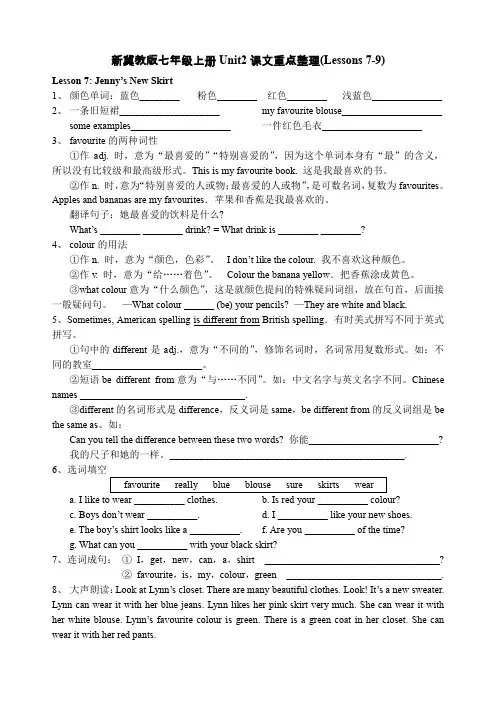
新冀教版七年级上册Unit2课文重点整理(Lessons 7-9)Lesson 7: Jenny’s New Skirt1、颜色单词:蓝色________ 粉色________ 红色________ 浅蓝色______________2、一条旧短裙____________________ my favourite blouse____________________some examples____________________ 一件红色毛衣____________________3、 favourite的两种词性①作adj.时,意为“最喜爱的”“特别喜爱的”,因为这个单词本身有“最”的含义,所以没有比较级和最高级形式。
This is my favourite book. 这是我最喜欢的书。
②作n.时,意为“特别喜爱的人或物;最喜爱的人或物”,是可数名词,复数为favourites。
Apples and bananas are my favourites.苹果和香蕉是我最喜欢的。
翻译句子:她最喜爱的饮料是什么?What’s ________ ________ drink? = What drink is ________ ________?4、 colour的用法①作n.时,意为“颜色,色彩”。
I don’t like the colour. 我不喜欢这种颜色。
②作v.时,意为“给……着色”。
Colour the banana yellow.把香蕉涂成黄色。
③what colour意为“什么颜色”,这是就颜色提问的特殊疑问词组,放在句首,后面接一般疑问句。
—What colour ______ (be) your pencils? —They are white and black.5、Sometimes, American spelling is different from British spelling.有时美式拼写不同于英式拼写。
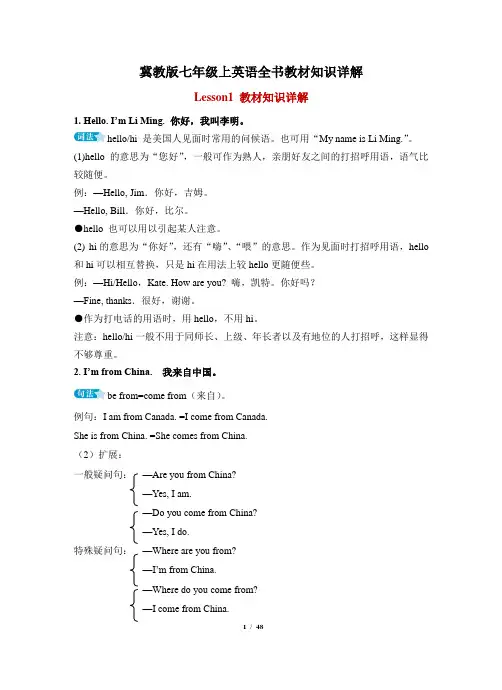
冀教版七年级上英语全书教材知识详解Lesson1 教材知识详解1. Hello. I’m Li Ming. 你好,我叫李明。
hello/hi 是美国人见面时常用的问候语。
也可用“My name is Li Ming.”。
(1)hello 的意思为“您好”,一般可作为熟人,亲朋好友之间的打招呼用语,语气比较随便。
例:—Hello, Jim.你好,吉姆。
—Hello, Bill.你好,比尔。
●hello 也可以用以引起某人注意。
(2) hi的意思为“你好”,还有“嗨”、“喂”的意思。
作为见面时打招呼用语,hello 和hi可以相互替换,只是hi在用法上较hello更随便些。
例:—Hi/Hello,Kate. How are you? 嗨,凯特。
你好吗?—Fine, thanks.很好,谢谢。
●作为打电话的用语时,用hello,不用hi。
注意:hello/hi一般不用于同师长、上级、年长者以及有地位的人打招呼,这样显得不够尊重。
2. I’m from China.我来自中国。
be from=come from(来自)。
例句:I am from Canada. =I come from Canada.She is from China. =She comes from China.(2)扩展:一般疑问句:—Are you from China?—Yes, I am.—Do you come from China?—Yes, I do.特殊疑问句:—Where are you from?—I’m from China.—Where do you come from?—I come from China.3. What’s your name? 你的名字是什么?/ 你叫什么名字?询问别人姓名常用的问句,完整形式为:What is your name?类似的问句还有:May I know your name, please?Your name, please?常见的答语有:My name is …? I am…?例:—What’s your na me?—My name is Danny.—May I know your name, please?—I am Jenny.同样,如果询问他的/她的名字,就可以说:What’s his/ her name?4. How are you? 你好吗?/ 你怎么样?见面时的打招呼用语,常用的答语是:I am fine. 当然,在实际交际环境中,可以根据自己的具体情况回答,还可以说:I am just so-so. (还可以。
新冀教版七年级上册Unit3课文重点整理(Lessons 13-15)Unit 3: Body Parts and FeelingsLesson 13: Body Parts1、两只大眼睛____________________ 说英语________________________我的长胳膊____________________ 做面条________________________两只大脚______________________ 和我玩儿______________________do my homework________________ right hand______________________a football player_________________ talk with the mouth_______________2、 I can speak English and Chinese. 我能说英语和汉语。
句中的speak与say,tell有何区别?①speak在此处作及物动词,用于表示说、讲某种语言时,意为“讲、说”。
例如:你会讲汉语吗? ______________________________②say是及物动词,后接说话的内容作宾语,但不能直接跟某人作宾语,只能说say to sb.。
例如:你最好跟她道个歉。
You’d better __________________ her.③talk意为“谈论、说”,是不及物动词,常用于talk to / with sb.;talk about sth. / sb. 短语中。
例如:他和我谈论了那个电影。
He talked ______ me ______ the film.3、 I have ten fingers—just like you! 我有十根手指—就像你一样!like在句中作介词,意思是“像;如”。
例如:They are like brothers and sisters. 他们___________________________。
冀教版七年级上册英语知识点归纳总结一、词汇和语法1. 名词在冀教版七年级上册英语中,名词的用法主要包括单数形式和复数形式的变化,以及名词前的不定冠词和定冠词的使用。
还涉及到一些特殊名词的复数形式变化规则,如以f或fe结尾的名词变复数要将f 或fe变为v再加上-es。
2. 动词动词是英语中的重要构成部分,七年级上册的内容主要涉及动词的时态和动词的不规则变化。
学生需要掌握动词的一般现在时和一般过去时的构成和用法,并且要熟记一些常见的不规则动词的变化形式。
3. 冠词冠词是名词前的限定词,主要分为定冠词和不定冠词。
学生需要理解冠词在句子中的作用,能够正确地选择和使用冠词,使句子结构更加完整合理。
4. 介词介词是用来表示时间、地点、方向、原因、目的等词与词之间的关系的虚词。
在七年级上册英语中,介词的用法主要包括表示时间和地点的介词,学生需要在课文和练习中多加练习,并且掌握不同介词的具体用法和搭配,以便在表达中能够准确地使用介词。
5. 句型七年级上册的英语课本中包含了一些常见的句型,如肯定句、否定句、一般疑问句等。
学生需要通过课文和练习掌握这些句型的构成和用法,同时能够在实际交流中灵活运用。
6. 时态时态是动词在句中表示时间的形式,七年级上册主要涉及一般现在时和一般过去时,学生需要掌握这两个时态的构成和用法,能够在阅读和表达中正确地运用。
二、阅读和写作1. 阅读理解七年级上册的英语课本中包含了一些日常生活中常见的情景和故事,学生需要通过阅读理解来理解故事内容和抓住关键信息。
要能够通过阅读来获取信息、筛选信息和整合信息,培养自己的阅读能力。
2. 书面表达冀教版七年级上册的英语课本中还包含了一些书面表达的内容,如写信、写日记等。
学生需要通过这些练习来培养自己的写作能力,能够用简单的句子和词汇来表达自己的想法和情感。
三、听力和口语1. 听力训练七年级上册的英语课本中包含了一些听力材料,学生需要通过这些材料来训练自己的听力理解能力,能够听懂简短的日常用语和句子。
新冀教版七年级英语上册知识点总结新课标颁布以来冀教版教材改版后的七年级全册各单元短语与句型的总结。
2011本总结包括Unit 1短语:be from=come from 、1over there 、2a visiting student 、3have lessons=have classes 、4play sports=do sports=have sports 、5plan lessons 、6have fun=have a good /nice/great/ 、7time wonderfulguessing games 、8a shopping list 、9句型:’What、1s your /his/her name?My/His/Her name is-----How are you? 2m fine. And you? ’ Im good,thanks. ’ IGood morning! 34 This is------let sb. do sth. 5show sb.around 6s turn to do sth. ’s one’ It7Excuse me.May I have/borrow-----? 8See you later. 9Here you are! 10You are welcome. 11need to do sth. 12How/What about (doing) sth.? 13make a list 14Unit 2 短语:look at 、1come out 、2in the sky 、3be/get ready for 、4say goodbye to 、5、6catch a coldgo back/come back 、7put on--take off 、8go well with 、9take......out of 、10around the world=all over the world 、11句型: mix A and B---mix......together 、1s your favourite colour? ’What、2How many colours do you see? 、3、4Whose ......is this?be/get ready to do sth. 、5s go shopping. ’Let、6s too small/big/long/short for me. ’It、7 Unit 3 短语: play with 、1s homework ’do one、2feel blue 、3see red 、4listen to 、5s hand ’wave one、6stand against/upon 、7、8see a doctortake the medicine 、9have a headache/stomachache 、10stay home 、11have a good rest 、12look different/the same 、13句型:1make sth. for sb. 、use ......for/to...... 、2How tall is he/she?He/She is ....meters tall. 、3m .....meters tall. ’How tall are you?I、4s the matter? ’s wrong?=What’ What5Are you OK? 6You had better (not)do sth. 7d better go and see a doctor. ’ You8 Unit 4 短语:1.a glass/cup/can/bottle of2.write down3.would like4.take down 分发,传送5.pass around6.be away7.get enough rest8.Watch TVmuch too 与9.too much10.be short for 句型:s ) time to do sth. ’(It、1s ) time for sth. ’(It、2s for breakfast/lunch/supper? ’What、3What would you like (to do) sth? 、4have sth. for breakfast/lunch/supper 、5Do you want to come with me? 、6get sth. for sb. 、7Goodjob!/Well done!/Great!/Wonderful!/ 、8Excellent!/Perfect!9 take sb to some placeAre you ready to order? 10 11 How much is/are ......?12 Would you like something to drink?13 No problem! Unit 5 短语:the Smith family=the Smiths 、1walk to school 、2talk on the police radio 、3on weekends 、4play football 、5be close to 、6work hard at school 、7have fun=enjoy oneself 、8in the front of 与in front of、9in the wall 于on the wall、10lots of=a lot of 、11a basket of 、12look out=be careful 、13go on a picnic 、14have a birthday party 、15make a card 、1617 在正面on the front 、摆放餐具,布置餐桌Set the table 、18句型: What does he/she do?She/He is a...... 、1talk to sb. about sth. 、2、3How old is he/she?How old are you? 、4Happy birthday (to you) ! 、5use sth. to do sth. 、6make sth . for sb. 、7Unit 6 短语:get off......get on 、1get lost=be lost 、23s way to ’on one、look for 、4turn right/left 、5good luck 、6make a noise/make noises 、7of course 、8、9on the farmcome on 、10了解learn about/of 、11 s left/right ’on one、12reach,arrive 与get to 、13by bike/bus/train/plane/sea 、14take a taxi 、15next to 、16句型:Go down this street.Turn left at the traffic lights. 、1May I help you? 、2What can I do for you? 、3No problem! 、4、5Excuse me!Unit 7 短语:go swimming/skating 、1、2fly a kite 大优惠,大减价big sales、3倒计时,倒数数count down 、4 come after 、5开运动会have Sports Day 、6a leap year 、7 闰年talk about 、8get together 、9watch a movie/ see a film 、10go shopping 、11去爬山Go mountain climbing 、12句型:1What day is it today? 、s the weather like? ’How is the weather?=What、2节礼日Boxing Day! 、3 Happy New Year! 、4International Day! 、5National Day! 、6s Day! ’Teacher、7s Day! ’New Year、8the Spring Festival! 、9、10s the date? ’WhatUnit 8 短语:1 盛大的告别聚会a big goodbye party 、the capital of 、2了解,知道know about/of 、3 be famous as 与be famous for 、4、5in the cornerthe same (.....) as 、6English-speaking countries 、7a list of 、8句型:Thank you for (doing) sth. 、1What else do you know about? 、2。
第一单元句型和短语知识点归纳1、go on a trip to+地点去某地旅行2、the capital (city) of our country 我们的首都3、“too + 形容词或副词+to + 行为动词原型”——表示“太……而不能……”,4、be busy with/at sth 忙于干某事5、far (away) from+地点远离某地;6、shop①、名词——商店:go to the shop; 手工艺课②、动词——购物:go shopping / do some shopping .7、live in 居住在8、work hard in/at 努力学习(工作)9、invite sb to do sth 邀请某人干某事;invite sb to +地点邀请某人去某地9、want to do sth 想要干某事want sb to do sth 想要某人干某事(同would like)10、talk to/with sb 和某人交谈、和某人谈话talk about sth 谈论某事11、call 喊、打电话call sb (on the telephone) 给某人打电话call sb from spl 从某地打电话给某人12、leave for 动身去某地13、stay with sb 和某人住在一起14、交通方式:①by bus/bike/car/train/plane/sea /motor bike/boat/taxi②on a bus/bike/train/plane/motor bike/boat③take a bus/bike/car/train/plane/ motor bike/boat/taxi④其它:in a car/ boat/taxi ; on foot ; ride a bike .15、may I……?表示请求肯定回答:Yes, you may /Yes,please /Yes,of course /Sure .否定回答:No, you may not /No,you can`t /No,you mustn`t . 16、plan 名词——计划:make a plan for sth 为某事制定计划;plan 动词——计划:plan (for) sth为某事做计划;plan to do sth 计划干某事.17、need to do sth 需要去作某事;18、tell sb about/of sth 告诉某人关于某事.19、go back to spl 回到某地20、pack A with B :把B打包放进A中Eg:Xiaoming is packing her bag with her books .21、给某人写信:write to sb / write sb a letter / write a letter to sb ;22、a suit of clothes 一套衣服.23、a pair of shoes 一双鞋子;two pairs of glasses 两副眼镜;注意:pair短语在句中如果作主语,应根据pair的单复数决定谓语动词的单复数.24、Have a good trip ! 旅途愉快!第二单元句型和短语知识点归纳1、argue with sb about sth 因某事和某人争论2、get on 上车get off 下车3、be ready for sth 为某事做准备4、a ticket to Canada去加拿大的票5、in +某种语言——用某种语言speak+某种语言——说某种语言6、pardon me 对不起、请重复一遍=Excuse me7、have to(客观的必须)=must(主观上的必须)必须、不得不、一定得8、look out of 从……向外看out of sth 某物的外面9、here and there 到处、四处10、point to 指向point at指着point out 指出11、at the top of 在……的顶端at the bottom of在……的底部12、try to do sth 努力、设法干某事13、be from spl = come from spl 来自某地14、of course / Sure / Ok 当然16、place of interest /the interesting place 名胜古迹17、enjoy doing sth 喜欢干某事18、hope to do sth 希望干某事hope+宾语从句希望……19、I t’s time for sth / It’s time to do sth / It’s time for sb to do sth 该干某事的时候了20、wait for sb/sth 等待某人、某物wait for (sb) to do sth 等待(某人)干某事21、find out 查出、查明fing sb doing sth 发现某人正在干某事22、feel+形容词/ be +形容词:感觉怎么样23、a bowl of /a bottle of /a glass of /a cup of / a can of pop 一碗/ 一瓶/ 一杯/ 一听汽水24、be quiet 安静keep quiet 保持安静25、play a word game 玩一个单词游戏play with sb 和某人一起玩play with sth 玩弄某物如:Don’t play with fire ! 不要玩火!play +球类名词(不要the)play+the +乐器名词(必须要the)如:play the piano26、watch TV / a football match / a movie see a flim 看电影27、show sb sth=show sth to sb 给某人看某物28、take care of = look after 照看、照料、照顾29、look for 寻找第三单元句型和短语知识点归纳1、Let sb do sth 让某人干某事2、I speak good English = I speak English well .我英语讲得好.3、translate for sb 为某人翻译4、laugh at sth 嘲笑某人fly a kite / fly kites 放风筝5、have fun 玩得高兴have fun (in) doing sth 干某事玩得很开心=have a good timeenjoy oneself6、make fun 开玩笑=make a joke7、hurt one’s +身体部位:hurt my nose / hurt my arm .8、Don’t be afraid . 不要害怕Don’t worry . 不要担心9、be careful / look out 小心、当心10、worry about sth /sbbe worried about sth /sb 担心某物/ 某人11、put …… on…… 把……放在……上put……in…… 把……放进……里面put …… down……把……放在……下面12、take one’s picture 给某人照相take a picture /take pictures照相13、用with + 具体工具如:She write a letter to her pen friends with a pen .14、fall off 从……上掉下来15、help sb do sth 帮助某人干某事help sb with sth 在某方面帮助某人16、at the post office 在邮局17、break his tail 折断了他的尾巴18、at the traffic lights 在交通灯的地方19、There be + sb +动词ing 形式+地点(介词短语)某处有某人正在干某事20、on the left 在左边on the right 在右边21、on the postcard 在明信片上22、in the top、right corner of sth 在…的右上角23、go straight/ down …… 沿着……直走24、in an hour 一个小时以后25、write sb a letter / write a letter to sb / write to sb给某人写信26、a pair of chopsticks 一双筷子27、send sb sth /send sth to sb给某人寄(送)某物28、buy sb sth / buy sth for sb 给某人买某物29、be late for sth 干某事迟到30、turn left向左转turn right向右转31、begin/start to do sth /begin/start doing sth 开始干某事32、a gift for sb 给某人的礼物33、a kind of 一种all kinds of 各种各样的34、see sb doing sth 看见某人正在干某事(动作正在进行)see sb do sth 看见某人干了某事(动作发生的过程)35、许多many +可数名词much+不可数名词=a lot of/ lots of36、一点、a little +不可数名词一些 a few +可数名词37、some 用于肯定句any,当表示建议、请求或希望得到肯定回答时,问句中用some38、put on 穿上、戴上(穿的动作)wear 穿着、戴着(穿的状态)39、turn on 打开turn off 关闭turn up 调大……turn down 调小……40、停止干某事stop to do sth (停下来去做另外一件事)stop doing sth 停止正在干的事41、in front of 在…的前面在(室外)没有局限空间的地方的前面in the front of 在(室内)有限空间的地方的前面第四单元句型和短语知识点归纳1、Thank sb for sth .为某事谢谢某人.Thank sb for doing sth .谢谢某人干某事 .2、at the airport 在飞机场3、It is for you .它是给你的4、the first /second day 第一/二天5、This is sb at /in spl .这是某人在某地.6、This sth is for sb .这是给某人的某物.7、receive……from…… 收到来自……的……8、ask for 请求9、ask sb for sth 向某人要(请求)某物.10、on the way to spl 去某地的路上11、lose one’s way = be lost 迷路12、by the way 顺便说一下13、as soon as 一……就……14、here 、there、home 是表示地点的副词,其前不加介词15、It’s too +形容词+for sb .它对某人来说怎么样 .16、在……上面on两物相互接触above两物不接触over 垂直于物体上方七年级英语第五单元知识点归纳1、wait for sb/sth:等待某人/物2、have a good trip:旅途愉快3、one hour’s driving:一小时的驾驶(此处的“hour’s”是名词所有格,译为“一小时的”,“driving”则是名词)4、be the same age 同龄5、What’s the name of sth:.叫什么?6、get to work=begin our class:开始上课7、minus fifteen degree:零下15℃8、what shape is/are sth:某物是什么形状?9、make a chart:制图10、put...for...:用...代表...11、dry the dishes:擦干碗盘12、at the table:围桌而坐13、sit in a chair:指坐在有扶手的椅子上七年级英语第六单元知识点归纳1、感叹句:表示惊讶、愤怒、喜悦、赞赏.结构:What+a/an +形容词+名词(主+谓)!How+a+名词(主+谓)!Eg. What a beautiful girl she is != How beautiful the girl is!2、learn:学习的过程study:学习的结果3、play in the snow:打雪仗4、make a snowman:堆雪人5、tell sb about sth:告诉某人关于...6、pick up:捡起拿起7、at Christmas:在圣诞节8、— Merry Christmas!— The same to you!9、It one’s turn to do sth:该轮到某人做某事了10、on Spring Festival :在春节11、on rainy days:在雨天12、不规则形容词、副词比较级、最高级:little-less-leastmany/much-more-mostgood/well-better-bestbad/badly/ill-worse-worstfar-farther-farthest 或far-further-furthest(进一步的)七年级英语第七八单元知识点归纳1.teach sb to do sth:教某人做某事2.learn to do:学做某事3.be ready for sth/be ready to do sth:准备好做某事4.dissagree/agree with:不同意/同意某事5.like to do sth :喜欢做某事(偶然性)like doing sth:喜欢做某事(指个人习惯)6.be called:被叫做...7.chear for:为...欢呼8.在比分中表示几比几用“to”,如:3:4读作:three to four9.be good/bad for:对.有益/害10.How often:对频率进行提问eg.How often do you play tennis?Twice a week.11. need:(实义动词)need to do:需要做...need:(情态动词)need+动词原形12. It takes sb sometime to do sth:做某事花费某人多少时间13.for example:例如(通常放在句首)14.a helpful person:一个有益的人15.look+形容词:看起来...16.go+动名词:去做某事go swimming/shopping/fishing:去游泳/购物/钓鱼17.make sb/sth +形容词:是某人/物处于某种状态18.run into a tree:撞树19.look like:看起来像20.like...better than...:喜欢...胜过...21.exam paper:试卷22.be good at/do well in:擅长于...23.for+一段时间:表示该动作持续了一段时间24.fly home:坐飞机回家25.buy sth for sb/buy sb sth:给某人买某物26.in+一段时间:表示.之后,用于将来时。
冀教版七年级上英语各单元重点单词短语归纳Unit1 单元知识归纳【重点单词】Canada加拿大thanks n.谢谢four num.四five num.五over adv.在那边;在另一处student 学生classmate n.同班同学show v.指示;带路around adv.& prep.到处;在附近classroom n.教室office n.办公室;职务plan n. &v.计划fun n.有趣的事;玩笑lab n.实验室eraser n.橡皮擦guess v.猜测first adv. & num.第一;首先wall n.墙may v. aux.可以;可能excuse v.原谅OK adj. &adv. &int. (口语)好,不错,可以borrow v.借two num. 二three num.三store n.商店later adv.后来;以后need v. & n.需要thing n.东西;事情list n.列表,名单,目录【重点短语】be from…来自……over there 在那里homeroom teacher 指导教师in many different ways 用许多不同的方式in English 用英语visiting student 访问生show... around 带领……参观have lessons 上课play sports 进行体育运动have fun 玩得愉快play a game 玩游戏at the store 在商店stand up 站起来sit down 坐下look up 向上看look down 向下看jump up 跳起来jump down 跳下去point up 向上指point down 向下指shopping list 购物单【典句必背】What’s your name? 你叫什么名字?My name is…/I’m…我叫……(名字)。
新冀教版七年级上册Unit4课文重点整理(Lessons 19-21)Unit 4: Food and ReastaurantsLesson 19: Time for Breakfast1、 seven fifteen____________________ make a salad________________________一些面包_______________________ 一杯果汁___________________________ some cereal______________________ put …on …_________________________ 一杯茶_________________________ 你呢?_____________________________ 2、 Time for breakfast! 该吃早饭了!这一句省略了It is,原句型为It is time for sth.,意为“到……的时间了”;表达“到做某事的时间了”,用It is time to do sth.;表达“到某人做某事的时间了”,用It is time for sb. to do sth.。
例如:李明,到你擦黑板的时间了。
_____________________________________________________ 该吃午饭了。
_____________________________或____________________________________ 3、What’s for breakfast? 早饭吃点儿什么?for breakfast作“早餐”讲。
介词for在这里的意思是“作为”,但通常不翻译。
“What’s for + 三餐”表示“三餐吃什么?”。
这是一句泛泛的说法,在具体的应用中,常用“What do you have for …?”来向对方提问。
【最新整理,下载后即可编辑】2014-2015学年冀教版七年级英语上册《Unit 1 School and Friends 》课件Lesson 1Key points:Words: Canada thanksPhrase: be fromSentences:①What’s your name?My name is…②How are you? I’m fine. / I’m good.③Nice to meet you. Nice to meet you, too.Lesson 21. 介绍某人、某物时用:This is ….2. 在几班的表达:be + in + Class + 基数词例:I am in Class Six.You are in Class Five.3. Who 引导的特殊疑问句:Who is the man over there?He’s Mr. Jone s — our homeroom teacher.Who’s the girl with Mr. Jones?She’s Kate. She is a student.4. Be动词引导的一般疑问句:Is she a student?Yes. She’s our classmate.5. with 表示“和”,“和某人在一起”:Who’s the girl with Mr. Jones?I like to play basketball with my classmates.Can you go shopping with me?The woman with my mother is my aunt.Lesson 3Jack /dk/ 杰克(人名)visiting /`viziti/ adj.访问的;参观的show /u/ v.指示;带路around /raund/ adv.&prep. 到处;在附近classroom /`kla:sru:m/n. 教室office /`fis/ n. 办公室;职务plan /pln/ n.&v.计划fun /fn/ n. 有趣的事;玩笑lab /lb/ n.实验室Lesson 4Let’s = Let usLet’s do sth. 让我们……拓展:Let sb. do sth. 让某人做某事。
(sb.用宾格)1.一般疑问句:用来询问情况是否属实,朗读时用升调。
陈述句It is a pen. 它是一支钢笔。
—Is it a pen?它是一支钢笔吗?—Yes, it is.—No, it isn’t.答语结构:肯定回答:Yes, 主语+be.否定回答:No, 主语+be +not.2.with 做介词表示“与……在一起”with 做介词表示“用……” 强调工具,方式3.It’s one’s turn.轮到某人了。
It’s your/my/her/his/Jenny’s/Danny’s turn.Lesson 51.Excuse me. 劳驾;请原谅;打扰一下通常用于要打扰别人、打断别人谈话或吸引他人注意时。
e.g: Excuse me, can you help me? 打扰一下,你能帮我吗?2.(1)——May I have a book, Jenny?——OK. Here you are.(2)——May I borrow two pencils, Jenny?——Yes, you may. Here you are.(3)——May I have three crayons, Jenny?—— Sorry, Danny.由情态动词may引导的一般疑问句,表示说话人请求对方的许可,询问是否可以做某事。
肯定回答为OK;Sure(当然可以);Yes, you may.(是的,你可以。
)否定回答为No, you mustn’t.(不,你不可以);或者用遗憾的口吻告诉对方Sorry.3.I don’t have any crayons. 我没有蜡笔。
have v. 有don’t = do not do 为助动词,没有实际含义,此句为否定句。
Lesson 61.what about…?表示“……怎么样?” 用于征询对方的看法或意见,后加名词或动词-ing形式。
2.need to do sth. 需要做某事need sth 需要某物2014-2015学年冀教版七年级英语上册《Unit 2 Colors and Clothes 》课件Lesson 71. Don’t be late for class!be late for sth.意思是“干某事迟到/晚了”,类似的句型还有be late to do sth.如:Mr. Smith was late for the meeting yesterday.They were too late to save her.2. I have painted six new pictures this week!此句为现在完成时态,其结构为:主语+ have/ has +过去分词……,描述过去发生的而与现在有关的事或状态,或是从过去某时刻到现在为止这一段时间中发生的情况,换言之,现在完成时是表示从过去到现在的事情。
如:I have already finished my homework.我已经做完了我的作业。
He has been an English teacher for ten years.他当英语老师已经10年了。
3. I hope to see them sometime.sometime副词, “某一天”, 用于一般将来时态, 表示未来不确定的某个时候.I’m sure I’ll make a computer by myself sometime in the future.我相信将来的某个时候我一定会自己制造一台电脑。
4. Class starts in two minutes!in + 时间段“多长时间以后”,常用于将来时,提问时用How soon。
for + 时间段“多长时间”,提问时用How long。
—How long can I keep your book? —Two weeks.—How soon will our class start? —In ten minutes.Lesson 8a lot of = lots of 许多的,大量的make sb. do sth使某人做某事make …+adj使…怎么样see sb. do sth看见某人做某事(动作已完成)see sb. doing sth看见某人正在做某事talk about 谈论be good at = do well in 擅长,在某方面做得好help sb. with …在某方面帮助某人have/take an exam 考试Lesson 91. What’s the matter? 你怎么啦?关心询问人的常用语。
同义句:What's the matter with you?What's wrong with you?What happened to you?What's the trouble?What's up?2. sick adj.生病的ill 和sick都有"生病的有病的"之意但用法并不完全相同。
ill 表示"生病的有病的"这一意思时一般用作表语,不能作定语。
而sick 既可以作表语又可以作定语。
如"病人"可以说a sick man 或the sick, 但不能说an ill man 或the ill。
又如:She is ill / sick in bed. 她卧病在床。
She is looking after her sick father .她在照顾她生病的父亲。
sick 有"恶心的厌倦的"之意。
如The smell makes me sick.这气味使我感到恶心。
ill 作定语修饰名词时是"坏的邪恶的"之意。
如He is an ill man. 他是一个邪恶的人。
3. for two days 表示一个时间段,指动作持续了两天,强调“延续”。
For+一段时间是现在完成时态的标志词。
Since +过去时间是现在完成时态的标志词。
4. Good for you ! 是真有你的!!!有时可以用来说反语,即对方很差劲做了傻事,你可以讽刺他good for you.5.not …..at all .根本不,一点也不Not at all = That's all right.=You're welcome.= That's a pleasure.没关系”6.It's a date一言为定It's a date.就这么说定了例:Good idea! It's a date.好主意,就这么办。
7.be convenient for 对某人来说方便的。
这句句子一般是各考点,通常在选择第一道(介词)或翻译中出现。
例:如果您方便的话,明早9点会和好么?Can you meet at 9 tomorrow morning if it is convenient for you ?Lesson 101.Jenny and Bill meet at 3 o’clock to work on their project.to work on their project动词不定式短语作状语。
work on意为“继续工作,从事,实施”。
She knew how to work on the project.她知道如何实施这个方案(项目)。
He is working on a book.他正在写一本书。
?2. Jenny is on the computer.on the computer指“在电脑上(操作)”3.No noise, please! 请别喧哗!“No+名词/动名词”,常用于标语中,表示“禁止……”(一般在公共场所使用),常见的有:No smoking! 禁止吸烟! No parking! 禁止停车!No swimming! 禁止游泳! No spitting! 禁止吐痰!4 . She’s half an hour late! 她晚(迟)了半小时!形容词与数量词或词组连用时,要放在后面。
The road is about 50 metres wide.这条路大约宽50米。
Her two-year-old daughter is lovely.她的两岁的女儿非常可爱。